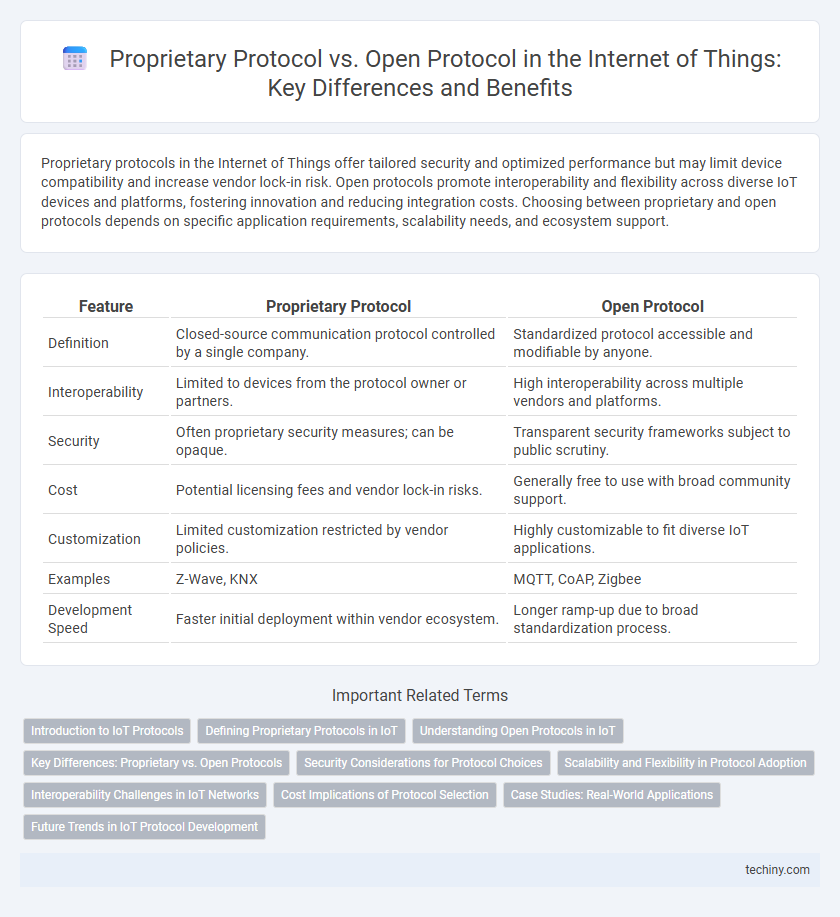Proprietary protocols in the Internet of Things offer tailored security and optimized performance but may limit device compatibility and increase vendor lock-in risk. Open protocols promote interoperability and flexibility across diverse IoT devices and platforms, fostering innovation and reducing integration costs. Choosing between proprietary and open protocols depends on specific application requirements, scalability needs, and ecosystem support.
Table of Comparison
| Feature | Proprietary Protocol | Open Protocol |
|---|---|---|
| Definition | Closed-source communication protocol controlled by a single company. | Standardized protocol accessible and modifiable by anyone. |
| Interoperability | Limited to devices from the protocol owner or partners. | High interoperability across multiple vendors and platforms. |
| Security | Often proprietary security measures; can be opaque. | Transparent security frameworks subject to public scrutiny. |
| Cost | Potential licensing fees and vendor lock-in risks. | Generally free to use with broad community support. |
| Customization | Limited customization restricted by vendor policies. | Highly customizable to fit diverse IoT applications. |
| Examples | Z-Wave, KNX | MQTT, CoAP, Zigbee |
| Development Speed | Faster initial deployment within vendor ecosystem. | Longer ramp-up due to broad standardization process. |
Introduction to IoT Protocols
IoT protocols govern communication between connected devices, with proprietary protocols offering customized, secure solutions tailored to specific ecosystems. Open protocols such as MQTT, CoAP, and HTTP provide interoperability, scalability, and ease of integration across diverse platforms. Choosing between proprietary and open protocols impacts device compatibility, network expansion, and long-term maintenance within IoT systems.
Defining Proprietary Protocols in IoT
Proprietary protocols in IoT are communication standards developed and controlled by a single company or organization, often resulting in restricted access and limited interoperability with devices from other manufacturers. These protocols optimize performance and security within a specific ecosystem but can create vendor lock-in, hindering device compatibility across different platforms. Examples include Zigbee and Z-Wave, which, despite being widely used, require specific gateways or adapters for cross-network communication.
Understanding Open Protocols in IoT
Open protocols in IoT enable seamless interoperability and standardized communication across diverse devices and platforms, fostering innovation and scalability. By utilizing universally accessible specifications like MQTT, CoAP, or HTTP, open protocols reduce vendor lock-in, enhance security through widespread scrutiny, and facilitate integration in complex IoT ecosystems. This openness accelerates deployment while ensuring long-term flexibility and supportability in smart environments.
Key Differences: Proprietary vs. Open Protocols
Proprietary protocols in the Internet of Things (IoT) are closed systems controlled by a single organization, offering optimized performance and enhanced security but limiting interoperability and scalability. Open protocols, such as MQTT and CoAP, promote device compatibility and flexible integration across diverse platforms, accelerating IoT deployment and innovation. Key differences include control, customization, community support, and long-term adaptability within evolving IoT ecosystems.
Security Considerations for Protocol Choices
Proprietary protocols in IoT often provide enhanced security through obscurity and controlled access, but they may lack widespread peer review, potentially hiding vulnerabilities. Open protocols benefit from extensive community scrutiny and rapid updates, promoting transparency and faster patching of security flaws, which strengthens overall resilience. Choosing between proprietary and open protocols requires balancing the need for robust, vetted security features against the risks of limited interoperability and unknown vulnerabilities.
Scalability and Flexibility in Protocol Adoption
Proprietary protocols often limit scalability and flexibility due to vendor lock-in and restricted interoperability, hindering seamless integration across diverse IoT devices. Open protocols enable greater scalability by supporting standardized communication frameworks that facilitate cross-platform compatibility and easier expansion. Flexibility in protocol adoption grows with open protocols, allowing developers to customize and innovate without constraints imposed by proprietary restrictions.
Interoperability Challenges in IoT Networks
Proprietary protocols in IoT often hinder seamless device communication due to limited compatibility with other systems, resulting in significant interoperability challenges. Open protocols, such as MQTT and CoAP, promote standardization and facilitate diverse device integration, enhancing network scalability. Overcoming interoperability barriers is critical for achieving efficient data exchange and unified IoT ecosystems.
Cost Implications of Protocol Selection
Proprietary protocols in the Internet of Things often lead to higher initial development and long-term maintenance costs due to licensing fees and limited vendor options. Open protocols reduce expenses by promoting interoperability, fostering community-driven improvements, and enabling integration with a diverse range of devices and platforms. Selecting an open protocol enhances scalability and cost-efficiency, particularly for large-scale IoT deployments with evolving connectivity requirements.
Case Studies: Real-World Applications
Case studies reveal that proprietary protocols, such as Zigbee used by Philips Hue, offer tailored security and optimized performance for smart lighting systems but limit interoperability across devices. Open protocols like MQTT and CoAP power extensive IoT deployments in industrial automation and smart agriculture, enabling cross-platform communication and scalability. Analysis highlights that choosing between proprietary and open protocols depends on application-specific requirements including security, device diversity, and ecosystem flexibility.
Future Trends in IoT Protocol Development
Proprietary protocols in IoT offer customized security and performance tailored to specific devices but often limit interoperability and scalability. Open protocols like MQTT, CoAP, and OPC UA are increasingly favored for their flexibility, widespread adoption, and support by industry consortia, driving standardization and seamless device integration. Future trends emphasize hybrid approaches combining proprietary enhancements with open standards to balance innovation, security, and ecosystem compatibility in IoT networks.
Proprietary protocol vs Open protocol Infographic

 techiny.com
techiny.com